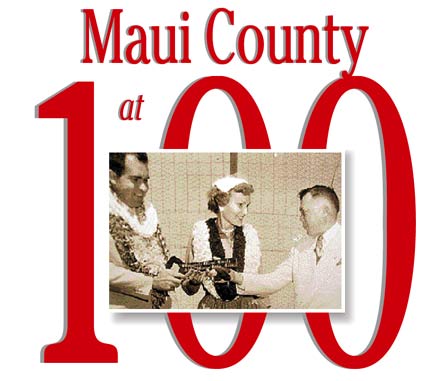
|
Events celebrate four islands'
contributions to history and culture
WAILUKU » The four-island county that brought Hawaii its first woman governor and the first Asian-American congresswoman is celebrating its 100th anniversary this year.
COUNTY MARKS 100
Some of the events marking the 100th anniversary of Maui County:
April 14: Proclamation Day
|
Maui County has organized several events to celebrate the establishment of the four-island government .
"With all of the changes that have taken place in the past 100 years, it would be beneficial for us to determine what good things, if any, we have lost or are on the verge of losing and what good things we have gained." said Antonio Ramil, an attorney who has written a history of Maui County entitled "Kalai`aina-County of Maui."
"This is a good time to remind ourselves that we are where we are today because of the choices that were made in the past."
Since its founding in 1905, when the territory of Hawaii was divided into five counties, the four-island Maui County has made some major choices and changes, serving as fertile ground for business innovation and the development of political leaders.
The Republican Party controlled Maui politics until World War II, Ramil said.

Maui has also been a foothold for immigrant sugar and pineapple workers, out of which arose labor unions, the Democratic Party and social reformers, such as the late U.S. Rep. Patsy Mink who co-authored Title IX federal legislation, enabling more women to participate in college sports nationally.
Molokai is where Republican Linda Lingle, publisher of a weekly newspaper, began her political career as an elected County Council representative in 1980, later to be mayor of Maui County before her election as governor in 2002.
The county has sometimes been at the forefront in making successful economic changes, especially in tourism where Maui has been the "Best Island In the World" for the 11th consecutive year in Conde Nast Traveller Readers' Choice Awards Poll.
Hawaii's first master-planned resort was developed in Kaanapali in West Maui in the early 1960s, in an effort to diversify Amfac's sugarcane land holdings.
Amfac and county officials also saw the value in preserving old buildings, declaring a portion of Lahaina Town a historic district in 1962, setting the stage for reviving its historic past as a former whaling port and capital of the Hawaiian Kingdom.
Once the largest pineapple plantation in the world, Lanai was transformed in the 1990s into an island with two world-class hotels.
Native Hawaiians in Maui County have played a part as cultural guardians.
Out of native Hawaiian protests on the Valley Isle about the exhumation of ancestral burials at a hotel development at Honokahua emerged a state law in 1990 creating island burial councils to oversee disposition of human remains.
The former Navy target island of Kahoolawe has become a focal point of the native Hawaiian renaissance.
Maui residents have also played a major role in preserving wildlife, including the establishment of Haleakala National Park in 1916 and the Hawaiian Islands Humpback Whale National Marine Sanctuary in 1997.
Lucienne de Naie, the vice chairwoman of the Hawaii chapter of the Sierra Club, said the centennial is an opportunity to obtain a perspective on the past 100 years.
"It gives people inspiration for the future," she said.
www.co.maui.hi.us
[News] [Business] [Features] [Sports] [Editorial] [Do It Electric!]
[Classified Ads] [Search] [Subscribe] [Info] [Letter to Editor]
[Feedback]
